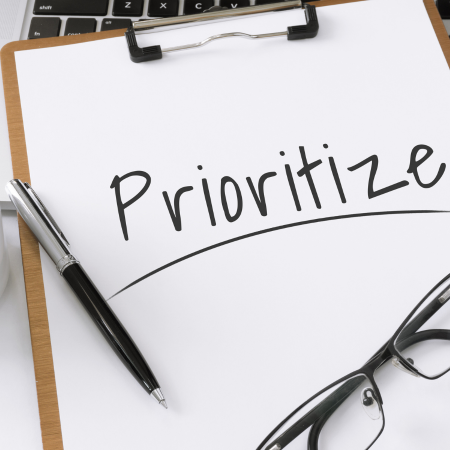“Molly Flexwell helps exhausted caregivers reclaim their energy, self-worth, and joy through practical tools and kindness-led living”
If you are a caregiver, you already know that time can feel like a living creature. Sometimes prowling and purring and then nip at your heels just when you think you have finally sat down with a cup of tea.
On many days, productivity feels like a dragon you are meant to slay, breathing smoke over your calendar, guarding a hoard of unfinished tasks, leaving you convinced you are always behind. But what if the goal is not to slay the dragon at all? What if the wiser path is to face it, name it, and learn to ride it, calm, clear, and utterly in charge?
In this blog postwe will guide you to doing exactly that. We will reality check your time, shape a kinder schedule, practise single task focus, read one book a week (yes, really), and use mindfulness to help you do fewer things at the same time, on purpose, so you can do the right things well.
Meet the Productivity Dragon

Picture your productivity dragon: vast, moody, and dramatic, shimmering with scales labelled emails, meals, medication, laundry, appointments, school forms, night shift, the “just checking” message, the “could you quickly” or I need your help, tasks. The dragon is not your enemy. It is your energy and attention, wild, powerful, and easily startled.
When the dragon flares up, we tend to do two things: We panic-plan. We write a list that could fuel a saga and call it a “day plan” or we multi-task. We stir the pot, answer a text, open an email, half-listen, half-work, then wonder why everything takes longer. It takes longer because we are not in mindfulness on one task at time. We as carers need them all done now! But what if, mindful productivity invites a third way. We face the dragon. We do a reality check. We ask the only question that matters: What time do I actually have, and what will truly move life forward today?
Reality Check: “What Time Do I Actually Have?”
This is the moment most productivity systems dont work for caregivers. Caregivers cannot pretend they have eight pristine hours of deep work. Your time comes in fractured fragments. The art is to plan for the real day, not the fantasy day.

Try a 7-day time scan (15 minutes total).
- Step 1: Name your fixed anchors. These are immovable commitments: medication rounds, school runs, clinical shifts, therapy appointments, sleep (please). Block them first.
- Step 2: Mark your flexible windows. These are elastic moments: 20–40 minutes between drop-off and the next call, 30 minutes after lunch, 15 minutes while the washing machine runs.
- Step 3: Spot your micro-pockets. Five to ten minutes: the kettle boil, the waiting room, the car park before pick-up.
- Step 4: Protect your recovery zones. Rest is not a reward; it is infrastructure. If you do not build recovery into your week, your week will take it from you anyway, with interest.
When you can see the shape of your days, you can choose wisely. A 40-minute window is not a novel-writing slot; it is a focused point. A five-minute window is not “too small”; it is a perfect moment for a micro-win.
Do Fewer Things at the Same Time (Single-Tasking Is a Superpower)
Multi-tasking looks clever, but the brain does not truly do tasks concurrently; it switches rapidly, losing energy each time. For caregivers already running on compassion and caffeine, switching tasking can be expensive. The antidote here is to single-task.
The Single-Task Rule: For the next block, I do one thing only.
- Micro version (5–10 minutes): Reply to one message fully. Wipe one surface. File three documents.
- Meso version (25–45 minutes): Finish a progress note. Draft a paragraph. Update a CV section.
- Macro version (60–90 minutes): Plan the week. Batch cook. Write a pitch.
Pair it with the Focus on Signal task : phone face-down, tabs closed, one note page open, timer set. Tell your brain what we are doing and how long we are doing it for. The dragon relaxes when it knows what happens next..
Schedule Like You Mean It (But Make It Kind)
A schedule is the soft fence you build around your day to stop it unravelling at the edges; keep it humane, because you are not a robot ticking boxes but a person carrying a lot, so let your calendar play the kindly bouncer, letting in what matters, asking the rest to come back later, and leaving space for breathers so you can actually enjoy the moments you are working so hard to protect.
A kind schedule has:
- Anchors: sleep, meals, meds, travel, handovers.
- Focus blocks: 25–90 minutes, matched to your actual energy.
- Admin gutters: 15-minute slots to triage small tasks (calls, forms, quick emails).
- Recovery moments: micro-rests (two minutes of breathing), real breaks (10–20 minutes outdoors), and weekly refuelling (a longer walk, a bath, a quiet sit with your book).
- Margins: 10–15 per cent white space for the unforeseeable (because life is exactly that).
A sample day for a busy carer (weekday):
- 06:30–07:30 Anchor: wake, meds, breakfast, light stretch.
- 08:00–08:30 Admin gutter: check messages, confirm appointments.
- 09:00–09:45 Focus block: paperwork or one essential task.
- 10:00–12:00 Caregiving tasks / appointments (immovable).
- 12:00–12:20 Recovery: lunch in the sun, three square breaths, no phone.
- 12:30–13:15 Focus block: “one frog” (the task you least want to do).
- 13:30–15:00 Caregiving tasks / domestic logistics.
- 15:15–15:30 Admin gutter: messages, refills, bookings.
- 16:00–18:00 Life stuff: school run, dinner prep, laundry.
- 20:00–20:30 Gentle close: one chapter of your weekly book.
- 22:00 Lights out (anchor).
This is not rigid; it is an agreement with yourself. Move the pieces. Keep the spirit going, when you need to go to focus and signal, do your mindfulness productivity and make sure your rest times are for you. Family time may even need to be scheduled. Remember you are in control and say to yourself that “I’ve got this “
The “One Book a Week” Habit (And Why It Boosts Productivity)

Reading looks indulgent until you realise it is mental cross-training schedule. One short book a week (or one long book over two weeks) builds focus, vocabulary, perspective, and stress recovery. It increases your tolerance, resiliance and productivity,
How to make it work when you are time-poor:
- Choose slim or structured. Essays, practical non-fiction with short chapters.
- Read in slices. 10–20 minutes at night, five minutes with the kettle, an audiobook on the school run, count the pages in the book to read brefore you start.
- Curate a “Focus Shelf.” Five pre-chosen titles so you do not waste energy deciding.
- Link it to your goals. Caregiver wellbeing, psychology, boundaries, leadership, gentle nutrition, or creativity.
Productivity angle: reading is deliberate practice for attention. You are training your mind to stay—just as you do in a focus block.
Case Study: The Carer Who Took One MBA Class per Semester
A real example (shared with permission, details adjusted for privacy). Susan a caregiver in her late thirties cared for her loving father in his late 80’s . She so wanted to keep her professional identity alive while managing unpredictable caring responsibilities. The fantasy plan “smash a full-time MBA in two years” was impossible. The reality plan one class per semester was sustainable.
What made it work:
- True time audit. She acknowledged her available energy and accepted it.
- Boundary schedule. Two evening focus blocks per week, 90 minutes each, planned around known care routines.
- Single-task study. One reading at a time, one assignment at a time, phone out of reach.
- Recovery prioritised. Non-negotiable sleep and outdoor walks so the work did not devour her.
- Outcome: three years later, four subjects done, no burnout, no shame. Identity intact. Confidence up. Momentum real. She felt amazing and in control.
The moral: progress over performance theatre. Realistic pace wins.
Mindfulness for Productivity (The Practical Version)
Mindfulness is not an aesthetic; it is a skill. For caregivers, it helps you step out of spiral and back into choice. Here are small, no-fuss practices that feed focus and reduce stress.
- Square Breathing (4×4). Inhale 4, hold 4, exhale 4, hold 4. Repeat for four rounds before every focus block.
- Arrival Cue. When you sit to work, say: “Here. Now. One thing.” Your brain loves rituals.
- Label the Distractor. Thought appears? Label it “planning,” “worrying,” or “remembering.” Then return. No drama.
- Two-Minute Close. At the end of a block, write down what you finished and the very next step. Closure calms the dragon.
- Compassion Reset. When the day derails (and it will), put a hand on your chest and say, “This is hard, and I am doing my best.” Then pick the next right task. Time for gratitude journaling.
The “Do Fewer, Finish More” Method
Finishers are not faster; they are selective. Try this weekly planning ritual to get your dragon on side.
- The Sunday Brain Dump (20 minutes). Empty your head: everything you think you “should” do this week.
- Pick Your Frogs (3 of them). Choose three outcomes that would genuinely move life forward (book the appointment, submit the form, write the proposal) and on what days you will make them leap.
- Assign Time, Not Hope. Place each frog into a real block on a real day.
- Bundle the Pebbles. Put small tasks into two or three admin gutters.
- Defend the Margins. Add 10–15 per cent slack time.
- Review and Reduce. Cross off anything that does not serve care, health.
You will notice something cosy and powerful: your week becomes legible. Decisions get easier. Anxiety quietens. You have fewer plates to spin, and the ones you keep actually feed your life.
Micro-Wins and Momentum (Five-Minute Moves That Count)
Caregiver realities change by the hour. Keep momentum with moves that fit in tiny pockets.
- The One Email That Frees Wednesday. Confirm, cancel, or reschedule.
- The Two-Minute Tidy. Clear the surface you see most; it lightens your mind.
- The Three-Line Journal. What mattered, what worked, what is next.
- The Phone Prune. Delete five apps or mute five threads that pull you off course.
- The Glass of Water + Stretch. Hydrate, roll your shoulders, lower the jaw. The dragon purrs.
Boundaries: The Invisible Engine of Productivity

There is no productivity without boundaries. Boundaries are not walls; they are agreements that protect what matters.
- Time boundary: “I can talk after 3 p.m.”
- Attention boundary: “I am not on email before 10 a.m.”
- Energy boundary: “I am not the only back-up plan.”
- Space boundary: “This table is for calm and work. Laundry finds another chair.”
A boundary is only as strong as its consequence. Pair each one with a kind script and a follow-through. People learn your limits when you live them.
A 2-Hour Weekly Planning Ritual (Template)
Use this on a Sunday evening or Monday morning. Adjust the durations to fit your world.
- Arrive (5 minutes). Square breathing, tea poured, notebook open.
- Scan (10 minutes). Appointments, shifts, non-negotiables.
- Three Frogs (10 minutes). Choose 3 outcomes.
- Block (20 minutes). Put frogs into real time. Add admin gutters and recovery.
- Tools (10 minutes). Clear your desk, charge devices, prep documents, place your book by the bed.
- Meals & Movement (15 minutes). Plan two easy dinners, schedule two short walks.
- People (10 minutes). Send two messages now that prevent five messages later.
- Reduce (10 minutes). Remove one commitment. Create margin.
- Close (5 minutes). Write a simple promise: “This week I will finish X, Y, Z. Everything else is optional.”
When the Day Explodes (And It Very Well Might)
Some days the dragon stomps through your plans wearing muddy boots. Here is your three-step rescue kit.
- Stabilise. Two square breaths. Drink water. Move your shoulders.
- Refocus. Name the next five minutes: “I will clear the sink,” “I will call the clinic,” “I will open the document and write three lines.”
- Replan Lightly. Swap today’s frog to tomorrow, add a 15-minute admin gutter tonight, protect sleep.
You did not fail; the plan served you by showing you what to change.
The Quiet Metrics That Matter
Forget perfect apps and complicated dashboards. Track what proves the system is working.
- Frogs finished: 0, 1, 2, or 3 each week.
- Focus blocks kept: count them; celebrate them. Give yourself a gold star.
- Recovery minutes taken: tiny rests prevent big collapses.
- Pages read: your weekly book is a lighthouse.
- Moments of pride: one sentence nightly—what you did well.
These are the measurements of a life that is moving, not just spinning.
Why This Works (And Keeps Working)
Because it honours truth. Your time has edges. Your energy fluctuates. Your care is precious. When you face the productivity dragon and stop pretending your day has 48 hours, you make cleaner choices. You start finishing the right things. And you feel the quiet relief of being a person who keeps small promises to themselves.
Mindful productivity is not about squeezing more out of you. It is about giving your attention somewhere safe to land, again and again, until your days feel coherent, and your life moves where you actually want it to go. On the tough days, choose one small next step and let the rest wait its turn. You are not behind, you are learning a kinder rhythm, one steady choice at a time. You are building a new relationship with time, one that respects your life as it is. When the dragon roars, smile softly. You know what to do. Breathe. Choose one thing. Begin. Let the rest wait its turn.
Be gentle with yourself: even the fiercest dragon lowers its wings at dusk, let your kindness be the calm that teaches your fire where to rest. Molly
The Wellness Hive For Caregivers Collections
The Wellness Hive for Caregivers Collections/ Shop is a gentle corner of the internet devoted to the people who hold everything together. It is a shop designed for caregivers, nurses, shift workers, and supporters who are giving so much of themselves and want simple ways to refill their own cup. Inside, you will find kind, practical wellness tools that make everyday care a little lighter and a lot more loving.
What we offer
- Caregiver self-care tools: gratitude journals, affirmation cards, reflection prompts, and gentle grounding practices that fit into real life.
- Planners and diaries: week-to-view wellness diaries, daily routines, and printable planners that help you protect your time and energy.
- Mindful downloads: instant digital guides for breathing, grounding, and journalling, plus caregiver checklists and calm-in-a-minute rituals.
- Beautiful gifts: Art Nouveau and stained-glass inspired designs in soft, uplifting colours that bring a little joy to a long day.
- Resources for burnout prevention: practical strategies for boundaries, rest, and recovery, created with caregivers in mind.
Who it is for
- Family caregivers who are balancing appointments, emotions, and the unexpected.
- Nurses and healthcare workers seeking quick, repeatable resets between shifts.
- Mothers and parents who want five calming minutes that actually work.
- Anyone feeling overwhelmed and ready for small steps back to clarity and calm.
How our products help
- Reduce decision fatigue with ready-to-use checklists, routines, and prompts.
- Support mental health with simple grounding exercises and gratitude journalling.
- Build resilience through tiny, consistent practices that fit into busy days.
- Make self-care visible with beautiful tools that invite you to pause and breathe.
What makes us different
- Created by a caregiver for caregivers, with lived insight and compassionate design.
- Evidence-informed practices translated into everyday language and easy routines.
- A kindness-led philosophy that treats rest and support as necessary, not optional.
- Art that soothes: bees, florals, and stained-glass motifs that feel hopeful and calm.
How it works
- Digital items arrive instantly so you can start today.
- Physical items are printed with care and packed as if they were for a friend.
- Clear, human support if you ever need help choosing or using a product.
Our promise
Molly Flexwell helps exhausted caregivers reclaim their energy, self-worth, and joy through practical tools and kindness-led living. We will never add to your overwhelm. Every product focuses on clarity, usefulness, and kindness, so you can move through your day with more steadiness and a little more light.
